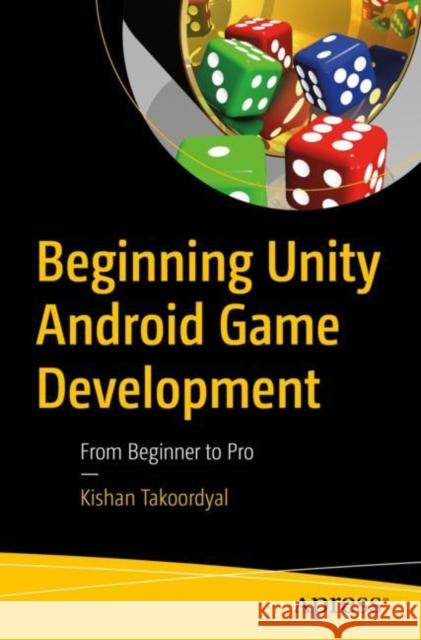Beginning Unity Android Game Development: From Beginner to Pro » książka



Beginning Unity Android Game Development: From Beginner to Pro
ISBN-13: 9781484260012 / Angielski / Miękka / 2020 / 255 str.
Beginning Unity Android Game Development: From Beginner to Pro
ISBN-13: 9781484260012 / Angielski / Miękka / 2020 / 255 str.
(netto: 196,31 VAT: 5%)
Najniższa cena z 30 dni: 206,62 zł
ok. 16-18 dni roboczych.
Darmowa dostawa!
Beginner User Level
Chapter 1: Programming Concepts
Chapter Goal: This chapter is intended to make the reader feel comfortable with basic programming concepts and operations. It will make further topics about game dev scripting more accessible to those with no past programming experience.
Sub -Topics:
1. Fundamentals of programming
2. Variables, constants, and types
3. Arithmetic operations
4. Boolean expressions
5. Selection
6. Iteration
7. Functions
Chapter 2: Introduction to Unity
Chapter Goal: This chapter provides an introduction to the Unity game engine and IDE. It shows how to navigate around, create basic objects and using transform tools to move, scale and rotate. The purpose of the Scene, Game, Hierarchy, Inspector, Project and Asset Store windows are also discussed.Sub -Topics:
1. Creating a Unity account
2. Downloading Unity and required add-ons
3. Scene view
4. Game view
5. Hierarchy window
6. Inspector window
7. Using the transform tools
8. Project window
9. Asset store window
Chapter 3: GameObjects, Prefabs, Materials, and Components
Chapter Goal: We learn more about GameObjects, the benefits of making prefabs, and the use of several components. A small overview of the need to use materials is also provided.Sub -Topics:
1. What are GameObjects and Prefabs
2. Transform component
3. Camera component
4. Lighting component
5. Renderer component
6. Collider component
7. Rigidbody component
8. Audio source component
9. Particle emitter component
10. Trail renderer component
11. Materials
Chapter 4: User Interface
Chapter Goal: The Canvas component is introduced and the reader will learn about making a game more interactive using touch input.
Sub -Topics:
1. The Canvas component
2. Text
3. Image/RawImage
4. Slider
5. Input field
6. Button
7. Introduction to input axes
Chapter 5: Building our first Android Game - Sphere Shooter
Chapter Goal: After creating a new project, we learn about switching to a more lightweight rendering pipeline. The reader will learn how to create the game environment, first enemy, player tank and bullets. Scripts will also need to be written to handle player movement, shooting, enemy instantiation and behavior.Sub -Topics:
1. The lightweight rendering pipeline
2. Creating game terrain and adjusting lighting
3. Making prefabs for the player, first enemy, and bullets
4. Player movement
5. Player shooting
6. Spawning enemies
7. Enemy movement
8. Enemy destruction
9. Game over
Chapter 6: Improving the Game - Sphere Shooter
Chapter Goal: We will learn how to make the game more interesting by creating simple but elegant canvas elements, introduce concepts such as health and score, make two more types of enemies, introduce pickups, add more sound effects to the game along with particle systems, implement mobile controls and exporting a build ready to be played.Sub -Topics
1. Fancy Menu when starting the game and dying
2. Adding the concept of score
3. Adding the concept of health
4. Implementing particle systems
5. Making a new faster enemy
6. Making a new bigger enemy
7. Creating a health pickup
8. Adding sound effects
9. Mobile joysticks
10. Editing player settings and exporting
11. What next?Kishan started out by learning programming at a young age with Python. Finding a bigger interest in game development, he has been developing games using the Unity game engine for over four years now. He is also a Linux lover and has worked on his own distribution. Currently, he resides in his home country, Mauritius, where he often participates in major technical events and hackathons with Cyberstorm.mu while developing quality games and improving his portfolio with new skills.
Master the art of programming games for Android using the Unity3D game engine. This book will help you understand basic concepts of game development in Unity. By the end of Beginning Unity Android Game Development, you will have the knowledge to confidently build an Android game.
The book starts by explaining simple programming concepts to make beginners comfortable with the jargon. You will then learn to navigate around the Unity interface and use basic tools (hand, move, rotate, scale, and rect). You will also be acquainted with the creation of basic 3D objects in the game while understanding the purpose of several of Unity’s windows.In the last chapters, you will learn to create a simple game for Android using the concepts studied in the previous chapters. Scripts will be written to handle the behaviors of the player and enemies as well as to handle other aspects of the game. The author shares tips along the way to help improve in-game performance, such as switching to the universal rendering pipeline when targeting mobile platforms.
At the end of the book, you will have a solid knowledge in making basic Android games that can be upgraded later to make more complex games.
You will:
- Explore basic Unity and C# programming concepts and scripting for Android games
- Navigate around the Unity interface and use its basic tools
- Make the most of popular components and features of Unity
- Write an Android game with optimizations
1997-2025 DolnySlask.com Agencja Internetowa
KrainaKsiazek.PL - Księgarnia Internetowa









